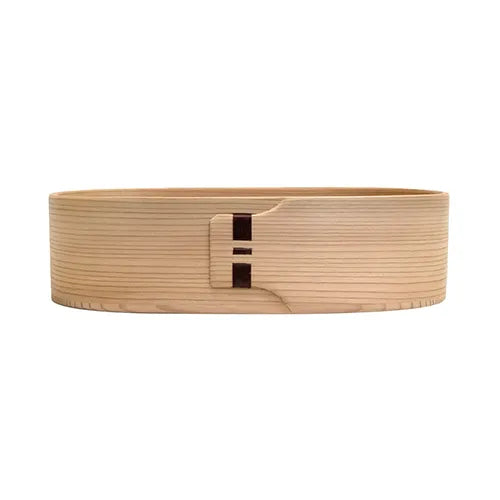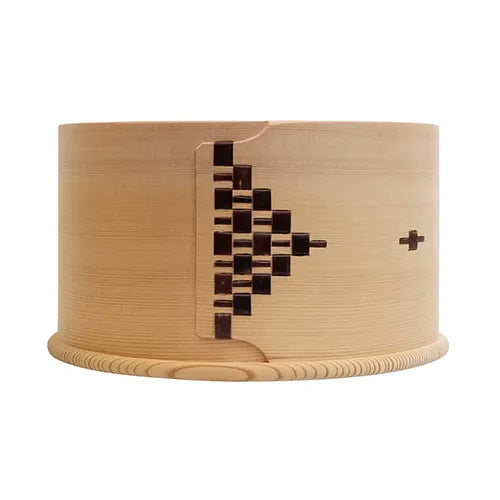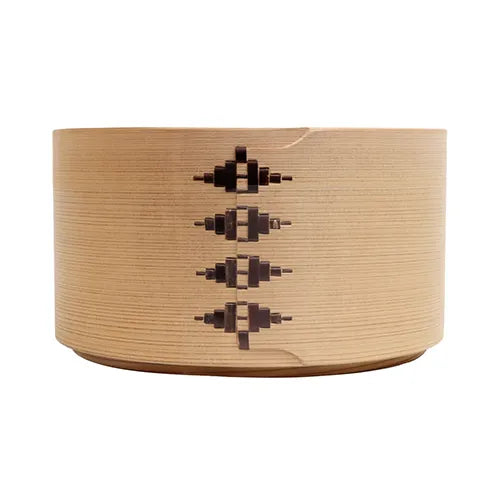樺綴じについて



樺綴 じとは
ABOUT KABATOJI WILD CHERRY BARK STITCHING
大館曲げわっぱをはじめ、日本の様々な地域で作られる曲げ物の合わせ目には、古くから山桜の木皮(樺)が用いられています。曲げわっぱ本体に目通しで穴を開け、縫い通す作業が「樺綴じ」と呼ばれる工程です。 Since ancient times, wild cherry bark, which is called Kaba, has been used to join the seams of bentwood objects made in various regions of Japan, including the famous Odate Magewappa. The process of sewing the bark through holes drilled in the bentwood body is called "Kabatoji".
採取した樺はよく乾燥させたのちに艶が出るまで磨き、製品の大きさに合った長さ、細さに裁断します。 After being carefully dried, the harvested wild cherry bark is polished to a shine and then cut to the appropriate length and width for the product.
合わせ目にご飯を練って作った糊や膠を使っていた時代には、それを更に補強するために樺綴じがなされてきました。しかし、高い性能の接着剤がある現在では、装飾的な意味合いが強いといえます。 In the past, when rice paste or animal glue was used to join the seams, Kabatoji was used to further strengthen the bond. However, with the advent of high-performance adhesives, it now serves primarily as a decorative element.
柴田慶信商店が曲げわっぱに使う樺は全て、職人自ら大館市内の山で採取したもの。整備された山道を歩くのではなく、時には茂みをかき分けて、山桜の木を目指します。樹皮は一度剥がしてもしばらくすると再生し、最初に剥がした樹皮は一番皮、再生したものは二番皮と呼ばれています。柴田慶信商店で使用しているのは、一番皮のみです。 All the wild cherry bark used by Shibata Yoshinobu Shoten for our Magewappa is harvested by our craftsmen from the mountains of Odate City. Instead of walking on well-maintained trails, the harvesters sometimes push through bushes and brambles to find cherry trees. The bark can be peeled off and regenerated after a while. The first peeled bark is called "Ichiban-Gawa", and the regenerated bark is called "Niban-Gawa". Shibata Keishin Shoten only uses Ichiban-Gawa for their products.
大切な綴じ模様 PRECIOUS STITCHING PATTERNS
柴田慶信商店の樺綴じの代表的な模様は、子持ち縫い・鱗綴じ・両鱗綴じの3種類がございます。古い曲げ物に学んだ慶信が考案して以来、現在に至るまで大切に受け継いできました。
それぞれの綴じ模様は商品の種類やサイズ、材料などに合わせ、作り手が機能と意匠を考えながら施しております。用と美を兼ね備えた最善の綴じ模様は、柴田慶信商店の思いや願いを託したものです。
Shibata Yoshinobu Shoten offers three main types of Kabatoji stitching patterns: Komochinui, Urokotoji, and Ryo-Urokotoji. These patterns were originally developed by Yoshinobu after studying old bentwood objects. They have been carefully passed down to the present day.
The choice of stitching pattern for each product is made by the craftsman, who considers the type, size, and material of the product, as well as both functionality and design. The best stitching pattern, which combines both utility and beauty, embodies the thoughts and wishes of Shibata Yoshinobu Shoten.
令和5年に柴田慶信商店の、子持ち縫い・鱗綴じ・両鱗綴じが、特許庁より登録商標として正式に登録されました。 In 2023, Shibata Yoshinobu Shoten's Komochinui, Urokotoji, and Ryo-Urokotoji stitching patterns were officially registered as trademarks by the Japan Patent Office.

子持ち縫い(登録第6678653号)Komochinui Stitching (Registered Trademark No. 6678653)
主に弁当箱に綴じられている模様です。樺の長短により親と親の間に子どもがいる様を表しました。子孫繁栄を願う模様として縫われております。This pattern is mainly used on bento boxes. It depicts the image of children between parents by using long and short pieces of cherry bark. The bark is sewn with the hope of prosperity for future generations.
鱗綴じ(登録第6678654号)Urokotoji Stitching (Registered Trademark No. 6678654)
古来より厄除けの意味があるとされてきた鱗の文様。おひつや飯切など、大型の製品に施しております。Since ancient times, it has been believed that this scale pattern can ward off bad luck. This pattern is used on Ohitsu and Hangiri, etc., and is mainly applied to large products.


両鱗綴じ(登録第6678655号)Ryo-Urokotoji Stitching (Registered Trademark No. 6678655)
ふたつの鱗が向かい合う模様。より装飾性を高めたこの模様は、飯器やシャンパンクーラーなど、より樹齢の高い天然杉を使用した商品に施しております。A pattern of two scales facing each other, this is a more decorative pattern. It is used for Hanki and Champagne-Coolers, and is applied to products made from older, natural cedar trees.



